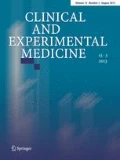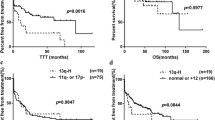Abstract
To determine the prognostic impact of de novo deletion 17p13.1 (17p–) in previously untreated chronic lymphocytic leukemia (CLL) patients, we prospectively studied the outcome of 71 treatment-naïve CLL patients. About 18.3 % of them had 17p– detected by interphase fluorescent in situ hybridization (FISH) at diagnosis. There was statistically significant difference between 17p– negative and positive patients as regards 2-year overall survival [OS] (89.7 vs. 53.8 %, respectively; P = 0.001). On the other hand, 2-year progression-free survival [PFS] was also significantly higher in 17p– negative group than in 17p– positive one (82.8 vs. 23.1 %, respectively; P < 0.001). On univariate analysis for OS, 17p– positivity was significantly associated with shorter OS (P = 0.003). However, when we performed multivariate analysis, 17p– lost its significant impact. On the other hand, 17p– positivity was a significant risk factor for PFS in both univariate and multivariate analyses [independent risk factor] (P < 0.001 and P = 0.02, respectively). So, 17p– is a predictor for disease progression, but not for survival in CLL patients.


Similar content being viewed by others
References
Hallek M. Signaling the end of chronic lymphocytic leukemia: new frontline treatment strategies. Hematol Am Soc Hematol Educ Progr. 2013;2013:138–50.
Hallek M. Prognostic factors in chronic lymphocytic leukemia. Ann Oncol. 2008;19(Supplement 4):iv51–3.
Gonzalez D, Martinez P, Wade R, et al. Mutational status of the TP53 gene as a predictor of response and survival in patients with chronic lymphocytic leukemia: results from the LRF CLL4 Trial. J Clin Oncol. 2011;29(16):2223–9.
Moreno C, Montserrat E. Genetic lesions in chronic lymphocytic leukemia: What’s ready for prime time use? Haematologica. 2010;95(1):12–5.
Stilgenbauer S, Zenz T, Winkler D, et al. Subcutaneous alemtuzumab in fludarabine-refractory chronic lymphocytic leukemia: clinical results and prognostic marker analyses from the CLL2H study of the German Chronic Lymphocytic Leukemia Study Group. J Clin Oncol. 2009;27:3994–4001.
Zainuddin N, Murray F, Kanduri M, et al. TP53 mutations are infrequent in newly-diagnosed chronic lymphocytic leukemia. Leuk Res. 2011;35(2):272–4.
Foà R, Del Giudice I, Guarini A, et al. Clinical implications of the molecular genetics of chronic lymphocytic leukemia. Haematologica. 2013;98(5):675–85.
Lin K, Adamson J, Johnson GG, et al. Functional analysis of the ATM-p53-p21 pathway in the LRF CLL4 trial: blockade at the level of p21 is associated with short response duration. Clin Cancer Res. 2012;18:4191–200.
Brown CJ, Lain S, Verma CS, et al. Awakening guardian angels: drugging the p53 pathway. Nat Rev Cancer. 2009;9(12):862–73.
Hillmen P. Using the biology of chronic lymphocytic leukemia to choose treatment. Hematol Am Soc Hematol Educ Progr. 2011;2011:104–9.
Tam CS, Shanafelt TD, Wierda WG, et al. De novo deletion 17p13.1 chronic lymphocytic leukemia shows significant clinical heterogeneity: the M. D. Anderson and Mayo Clinic experience. Blood. 2009;114:957–64.
Best OG, Gardiner AC, Davis ZA, et al. A subset of Binet stage A CLL patients with TP53 abnormalities and mutated IGHV genes have stable disease. Leukemia. 2009;23:212–4.
Pei J, Jhanwar SC, Testa JR. Chromothripsis in a case of TP53-deficient chronic lymphocytic leukemia. Leuk Res Rep. 2012;1:4–6.
Hallek M, Cheson BD, Catovsky D, et al. Guidelines for the diagnosis and treatment of chronic lymphocytic leukemia: a report from the International Workshop on Chronic Lymphocytic Leukemia updating the National Cancer Institute-Working Group 1996 guidelines. Blood. 2008;111:5446–56.
Chevallier P, Penther D, Avet-Loiseau H, et al. CD38 expression and secondary 17p deletion are important prognostic factors in chronic lymphocytic leukaemia. Br J Haematol. 2002;116:142–50.
Delgado J, Espinet B, Oliveira AC, et al. Chronic lymphocytic leukaemia with 17p deletion: a retrospective analysis of prognostic factors and therapy results. Br J Haematol. 2012;157:67–74.
Dohner H, Fischer K, Bentz M, et al. p53 gene deletion predicts for poor survival and non-response to therapy with purine analogs in chronic B-cell leukemias. Blood. 1995;85:1580–9.
Dohner H, Stilgenbauer S, Benner A, et al. Genomic aberrations and survival in chronic lymphocytic leukemia. N Engl J Med. 2000;343:1910–6.
Krober A, Seiler T, Benner A, et al. V(H) mutation status, CD38 expression level, genomic aberrations, and survival in chronic lymphocytic leukemia. Blood. 2002;100:1410–6.
Oscier DG, Gardiner AC, Mould SJ, et al. Multivariate analysis of prognostic factors in CLL: clinical stage, IGVH gene mutational status, and loss or mutation of the p53 gene are independent prognostic factors. Blood. 2002;100:1177–84.
Dewald G, Brockman S, Paternoster S, et al. Chromosome anomalies detected by interphase fluorescence in situ hybridization: correlation with significant biological features of chronic lymphocytic leukemia. Br J Haematol. 2003;121:287–95.
Xu W, Li JY, Li L, et al. Fluorescent in situ hybridization with a panel of probes detects molecular cytogenetic abnormalities in patients with chronic lymphocytic leukemia. Zhonghua Yi Xue Za Zhi. 2008;88(36):2537–40.
Michalová K, Zemanová Z, Cmunt E, et al. The interphase fluorescence in situ hybridization (I-FISH) technique in patients with chronic lymphatic leukemia (CLL). Cas Lek Cesk. 2000;139(11):334–8.
Grever MR, Lucas DM, Dewald GW, et al. Comprehensive assessment of genetic and molecular features predicting outcome in patients with chronic lymphocytic leukemia: results from the US intergroup Phase III trial E2997. J Clin Oncol. 2007;25(7):799–804.
Zenz T, Habe S, Denzel T, et al. Detailed analysis of p53 pathway defects in fludarabine-refractory chronic lymphocytic leukemia (CLL): dissecting the contribution of 17p deletion, TP53 mutation, p53-p21 dysfunction, and miR34a in a prospective clinical trial. Blood. 2009;114:2589–97.
Zenz T, Eichhorst B, Busch R, et al. TP53 mutation and survival in chronic lymphocytic leukemia. J Clin Oncol. 2010;28:4473–9.
CLL Trialists’ Collaborative Group. (CLLTCG). Systematic review of purine analog treatment for chronic lymphocytic leukemia: lessons for future trials. Haematologica. 2012;97(3):428–36.
Tam CS, O’Brien S, Wierda W, et al. Long-term results of the fludarabine, cyclophosphamide, and rituximab regimen as initial therapy of chronic lymphocytic leukemia. Blood. 2008;112(4):975–80.
Parikh SA, Keating MJ, O’Brien S, et al. Frontline chemoimmuno-therapy with fludarabine, cyclophosphamide, alemtuzumab, and rituximab for high-risk chronic lymphocytic leukemia. Blood. 2011;118(8):2062–8.
Castro JE, James DF, Sandoval-Sus JD, et al. Rituximab in combination with high-dose methylprednisolone for the treatment of chronic lymphocytic leukemia. Leukemia. 2009;23:1779–89.
Byrd JC, Furman RR, Coutre SE, et al. Targeting BTK with ibrutinib in relapsed chronic lymphocytic leukemia. N Engl J Med. 2013;369(1):32–42.
Schetelig J, van Biezen A, Brand R, et al. Allogeneic hematopoietic stem-cell transplantation for chronic lymphocytic leukemia With 17p deletion: a retrospective European Group for Blood and Marrow Transplantation analysis. J Clin Oncol. 2008;26(13):5094–100.
Rossi D, Rasi S, Spina V, et al. Integrated mutational and cytogenetic analysis identifies new prognostic subgroups in chronic lymphocytic leukemia. Blood. 2013;121(8):1403–12.
Conflict of interest
None.
Author information
Authors and Affiliations
Corresponding author
Rights and permissions
About this article
Cite this article
El-Ghammaz, A.M.S., Abdelwahed, E., Mostafa, N.N. et al. De novo deletion 17p13.1 as a predictor for disease progression in chronic lymphocytic leukemia. Clin Exp Med 15, 493–499 (2015). https://doi.org/10.1007/s10238-014-0317-2
Received:
Accepted:
Published:
Issue Date:
DOI: https://doi.org/10.1007/s10238-014-0317-2




